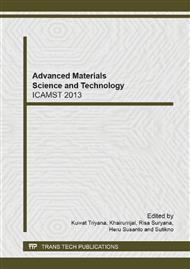p.537
p.541
p.545
p.549
p.553
p.557
p.562
p.566
p.570
Development of Geopolymer Utilizing Inorganic Waste Materials
Abstract:
Geopolymers, which are produced by the reaction between aluminosilicate solid precursors and concentrated alkali solutions, is an environmentally attractive construction material due to its much smaller carbon footprint compared to ordinary Portland cement (OPC), and its ability to consume a wide range of solid inorganic waste materials. This work describes the synthesis of geopolymers utilizing local aluminosilicate materials and the evaluation of several key engineering properties of the geopolymer product as a construction cement. A simple 22 factorial experiment is undertaken to measure the effect of types aluminosilicate solids (metakaolin produced by calcining a Belitung kaolin at 750 °C, and coal fly ash from an East Java baseload powerplant) and alkali activators (NaOH and KOH solutions) on the initial and final setting time of the geopolymer cement mortar. All geopolymer mortar samples exhibit longer setting times compared to OPC mortars. Statistical analysis indicates that KOH produces faster initial setting than NaOH, while fly ash produces faster setting times compared to metakaolin. A 23 factorial experiment is conducted subsequently, adding curing temperature (60 and 80 °C) to the experimental factors. The key engineering property measured in the second experiment is the compressive strength of geopolymer mortars. ANOVA treatment of the measured data indicates that all three experimental factors significantly impacts the compressive strength. Consistent with the preceding experiment, the use of fly ash and KOH significantly increases the strength of the geopolymer mortar. Higher curing temperature is also found to increase the strength. The use of metakaolin as geopolymer precursor produces compressive strength approximately 50% than that of the OPC mortar, while fly ash produces a geopolymer mortar strength that is at least as good as OPC.
Info:
Periodical:
Pages:
553-556
Citation:
Online since:
February 2014
Keywords:
Price:
Сopyright:
© 2014 Trans Tech Publications Ltd. All Rights Reserved
Share:
Citation:


